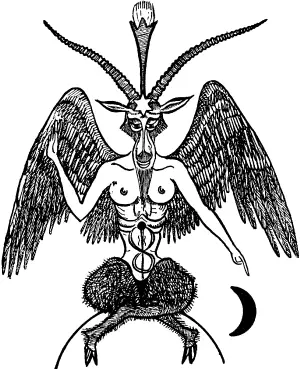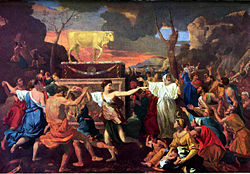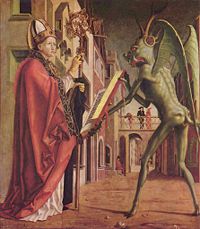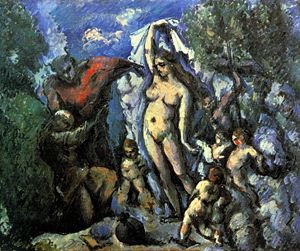Devil
The Devil is the title given to the supernatural being who is believed to be a powerful, evil entity and the tempter of humankind. The name "Devil" derives from the Greek word diabolos, which means "accuser." In Christianity, God and the Devil are usually portrayed as competing over the souls of humans, with the Devil seeking to lure people away from God and into Hell. The Devil commands a force of lesser evil spirits, commonly known as demons.
The Hebrew Bible does not assign this level of personification to the Devil. Instead, the adversary (ha-satan) is a servant of God whose job is to test humankind. However, in the Jewish apocrypha and rabbinical tradition, the Devil took on many of the characteristics inherited by Christianity.
The Devil is referred to by a variety of names, including Abbadon, Angra Mainyu, Satan, Asmodeus, Beelzebub, Lucifer, Belial, and Iblis. Many other religions have figures similar to the Devil.
The Devil is commonly associated with heretics, infidels, and witches. Modern conceptions of the Devil include the idea that he symbolizes humanity's own lower nature or sinfulness, or is a projection of unconscious human energies. In some traditions, believers gain power over the Devil through their faith, righteousness, or knowledge of the truth, and thus come to prosecute him before God, rather than the other way around.
The Devil in Abrahamic religions
Judaism
In the Hebrew Bible, the concept of the Devil is not highly developed, and Satan is only mentioned a few times. The idea took form in later Jewish writings, however, and was further elaborated in the rabbinical tradition.
In the Bible, "Satan" is not so much a proper name but an office: "The satan." In Hebrew, the word ha-satan (שָ××Ö¸×) means "the adversary" or even "the prosecutor" or accuser. In the Book of Job, ha-satan is the title of an angel, one of the "sons of God" who comes to report to God. After God proudly points out Job's piety, ha-satan asks for permission to test the faith of Job. God grants ha-satan this power, and the righteous man is afflicted with loss of family, property, and, finally, his health. However, the book is clear in its view that none of this happens outside of God's sovereign will.
The idea of Satan as the accuser is retained in Zech. 3:1-2, where he is described as the adversary of the high priest Joshua. In the book of 1 Chronicles 21:1, ha-satan acts as the more traditional Devil when he incites David to an unlawful census. However, the earlier version of this story in 2 Samuel 24:1 portrays God himself, moved by anger, as leading David to this sinful act. The Book of Isaiah, Job, Ecclesiastes, and Deuteronomy all have passages in which God is credited for exercising sovereign control over both good and evil.
In the Jewish apocrypha, however, Satan's role came to resemble more closely the character normally associated with the Devil. In the Book of Wisdom 2:24 he is represented as the author of all evil, who brought death into the world. He was the seducer and the paramour of Eve, and was hurled from heaven together with other angels because of his iniquity (Second Book of Enoch 24). Since that time he has been called "Satan," although previously he had been termed "Satanel" (ib. 32:3). Satan rules over an entire host of angels (Martyrdom of Isaiah 2:2; Life of Adam and Eve 16). It was Mastema, another name for Satan (Book of Jubilees, 17:18), who induced God to test Abraham through the sacrifice of Isaac. In the Book of Tobit, Asmodeus is likewise identified with Satan, especially in view of his licentiousness. As the lord of other devils, he sometimes bears the special name Samael. In the New Testament, the opponents of Jesus accuse him of being an agent of Beelzebub, and this may be an accurate reflection of popular Jewish attitudes of the time regarding the Devil's work with sorcerers and witches.
Talmudic Judaism reflected these popular concepts of the Devil. Samael, the lord of the satans, was formerly a mighty prince of angels in heaven (Gen. R. xix.). Like all celestial beings, he flies through the air (Gen. R. xix.) and can assume any form, as of a bird (Sanh. 107a), a stag (ib. 95a), a woman (Ḳid. 81a), a beggar (ib.), or a young man (Tan., Wayera). He is said to "skip" (Pes. 112b; Meg. 11b), in allusion to his appearance in the form of a goat. He is the incarnation of all evil, and his thoughts and activities are devoted to the destruction of humanity. Satan, the impulse to evil ("yetzer ha-ra'"), and the angel of death are one and the same personality.
Satan the serpent was an active agent in the human fall (Pirḳe R. El. xiii) and was even the father of Cain (ib. xxi). He was also instrumental in the death of Moses (Deut. R. xiii. 9) and in David's sin with Bathsheba (Sanh. 95a). If Satan does not attain his purpose, as was the case in his temptation of Job, he feels great sorrow (B. B. 16a). It was a terrible blow to him that the Torah should be given to Israel. He endeavored to overthrow it, and finally led the people to make the golden calf (Shab. 89a). He also appeared as a tempter to Rabbi Akiba (Ḳid. 81a).
Satan kindles the evil impulse to impurity (Ex. R. xx). In the hour of birth, he brings his accusation against the mother (Eccl. R. iii. 2). As the incarnation of evil, Satan is the arch-enemy of the Messiah: He is the Antichrist.
Christianity
In mainstream Christianity, the Devil is likewise known as Satan and is identified as the fallen archangel, Lucifer. In the Gospels, the Devil and his kingdom are regarded as encompassing the entire world, and are factors in all the events of daily life. He bears many names, being called "Satan" (Matt. 4:10, Mark 1:30, Luke 10:18, etc.), "devil" (Matt. 4:1 et passim), "adversary" (1 Peter 5:8, 1 Tim. 5:14), "enemy" (Matt. 13:39), "accuser" (Rev. 12:10), "ancient serpent" (Rev. 20:2), "great dragon" (Rev 12:9), Beelzebub (Matt. 10:25), and Belial. He is the author of all evil, who beguiled Eve (2 Cor. 11:3), and who brought death into the world (Heb. 2:13). He is ever the tempter (1 Thess. 3:5, 1 Peter 5:8), and was even able to tempt Jesus (Matt. 4). The Devil is identified with the serpent in the Garden of Eden and the dragon in the Book of Revelation. He is described as hating all humanity, opposing God, spreading lies and wreaking havoc on the souls of humankind.
In medieval Christian theology, the Devil was once the archangel Lucifer, but rebelled against God and has consequently been condemned to the Lake of Fire. Historically, he is thought to have inspired heretics, infidels, and all of those who oppose God and the Church. He is also strongly active in the life of many great saints, tormenting them and trying with all of this strength to tempt them to sin. As Baphomet, he allegedly seduced the Knights Templar to worship him. As Beelzebub, he caused untold evil through the works of witches. As the Antichrist, he is destined to deceive the majority of humankind, causing them to receive his mark of 666 on their foreheads. However, he and his followers will ultimately be defeated at the Second Coming of Christ, and will be thrown forever into the Lake of Fire.
Today, some Christians consider the Devil to refer figuratively to human sin and temptation, and to any human system in opposition to God. Some hold that the Devil, though admittedly a powerful force in human affairs, is actually the psychological projection of unconscious human energies.
Islam
In Islam, the Devil is referred to as Iblis. According to the Qur'an, God created Iblis out of "smokeless fire" (along with all of the other jinn) and created man out of clay. His great influence is due to his power to cast evil suggestions into the heart of men and women.
According to Muslim tradition, Iblis was expelled from the grace of Allah when he disobeyed God by choosing not to pay homage to Adam, the father of all mankind. He claimed to be superior to Adam, on the grounds that man was created of mere earth while he, Iblis, was created of fire. The angels dutifully prostrated themselves before Adam to show their obedience to God. However, Iblisâbeing unlike the angels in his ability to chooseâdecided not to bow. This caused him to be expelled by God, a fact that Iblis blamed on humanity. He therefore determined to bring mankind into disobedience as well. Initially, the Devil was successful in deceiving Adam and Eve, causing them to sin. However, they soon repented and were forgiven by God. Adam went on to become the world's first prophet and never sinned again. God gave the couple a strong warning about Iblis and the fires of Hell, commanding them and their children to stay away from the deceptions caused by the Devil.
The Qurâan teaches that the Devil's role, until the Resurrection Day, is to attempt to deceive Adam's children (mankind). After that, he will be put into the fires of Hell along with those whom he has deceived. The Qur'an depicts God as supremely sovereign over all his creations, and thus Iblis does not technically act outside of God's will. Iblis's single enemy is humanity. Thus, humankind is warned to struggle (jihad) against the mischief of the Devil. The ones who succeed in this are rewarded with Paradise, attainable only by righteous conduct.
The Devil in folklore
In the Western Christian and Jewish tradition, the Devil has entered popular folklore, particularly in his role as a trickster figure. He is found, for example, as a character in a large number of traditional folktales and legends from Ireland, Newfoundland, Italy, and the United Kingdom, where he often attempts to trick or outwit other characters. Similar tales exist in Jewish and Christian tradition in Eastern Europe. In some of these tales, the Devil is portrayed as more of a folk villain than as the personification of evil. In other popular stories, several of which have been made into Hollywood films, the Devil offers people power, wealth, and irresistibility to the opposite sex, in exchange for their souls.
The Devil also features prominently in a number of hagiographical tales, where he tempts the saints by adopting various disguises and torments them in graphic, often sexually suggestive, detail. Some of these tales, such as the popular legend of St. Dunstan, fall outside the authorized religious canon.
The Devil is also a recurring feature in tales explaining the etymology of geographical names, lending his name to natural formations, such as The Devil's Chimney. He also plays a role in folk music, such as the American fiddle songs "Devil's Dream" and "Up Jumped the Devil." In the blues tradition, the Devil supposedly gave certain players, such as notably Robert Johnson, great musical and spiritual power in a deal made at the crossroads at midnight.
In contemporary culture, the Devil figures prominently in popular fiction and film, such as The Exorcist, Rosemary's Baby, and many others.
The Devil in other religions
Hinduism
In contrast to Judaism, Christianity, Islam, and Zoroastrianism, Hinduism does not recognize any central evil force or entity, such as the Devil, opposing God. However, evil beings (for example, asuras) do sometimes oppose the will of the gods and cause human suffering.
A prominent asura is Rahu, whose characteristics are in some ways similar to those of the Devil. In Hindu mythology, Rahu is a snake that swallows the sun or the moon, causing eclipses. According to legend, Rahu drank some of the divine nectar of immortality. But before the nectar could pass his throat, Mohini (the female avatar of Vishnu) cut off his head. Rahu's head, however, remained immortal. Rahu also appears in Buddhist writings and art as one of the terror-inspiring deities.
In Hindu philosophy, the asuras are not nearly so powerful as in the Abrahamic tradition. Their powers are inferior and exist as illusions in the mind. Asuras may also be human beings in whom bad motivations and intentions have temporarily outweighed the good ones.
The demon Kaliânot to be confused with the goddess KÄlÄ«âmay also be mentioned. According to the Vishnu Purana, he is a negative manifestation of Vishnu who, along with his extended evil family, perpetually operates as a cause of the destruction of this world. In Ayyavazhi, the Satan-like figure, Kroni is a ravenous demon with multitudinous limbs each the size of a mountain, Kroni is the primordial manifestation of evil who appears in various formsâRavana, Duryodhana, and so onâin different ages or yugas. Kroni is said to be virtually omnipresent in this age.
Buddhism
A devil-like figure in Buddhism is Mara. He is a tempter, who also tempted Gautama Buddha by trying to seduce him with the vision of beautiful women who are often said to be Mara's daughters. Mara personifies unskillfulness and the "death" of the spiritual life. He tries to distract humans from practicing spirituality by making the mundane alluring or the negative seem positive. Another interpretation of Mara is that he actually is the desires that are present in one's own mind, preventing the person from seeing the truth. So in a sense Mara is not an independent being but a part of one's own being that has to be defeated.
In the daily life of the Buddha, the role of the Devil has been given to Devadatta, his cousin and jealous fellow monk who attempted to kill him and caused a schism in the monastic community.
Zoroastrianism
In Zoroastrianism, the adversary of the God of goodness is called Angra Mainyu. In the Gathas, the oldest texts of the Zoroastrian Avesta, the poet does not mention a manifest adversary of God. Here Ahura Mazda's creation is "truth," asha. The "lie" (druj) is manifest only as decay or chaos, not a personal entity. In classical Zoroastrianism, however, the good God Ahura Mazda, and his evil counterpart, Angra Mainyu, are the "twin" offspring of Zurvan, "Time." This concept of the struggle between personified good and evil is thought by many scholars to have influenced the concept of Satan as the Devil in Judaism during the Babylonian captivity, thus explaining why earlier Hebrew scriptures do not mention the Devil.
Today, the Parsis of India largely accept the nineteenth century interpretation that Angra Mainyu is the "Destructive Emanation" of Ahura Mazda. Instead of struggling against Mazda himself, Angra Mainyu battles Spenta Mainyu, Mazda's "Creative Emanation."
New ideas bout the Devil
Bahá'à Faith
In the Bahá'à Writings, "devil" or "satanic" can have a number of meanings. Sometimes it is used to refer to the Bahá'à interpretation of Satan. Other times it refers to people who are ruled by their own lower nature. In this sense, the Bahá'Ãs consider certain evil people to be devils incarnate, not in the sense of being ruled by an external evil force, but by their own selfish desires. The Báb referred to His persecutors as "the followers of the devil."[1]
The Bahá'à Faith teaches that Satan is also a metaphor for the "insistent self" or "lower self" which is a self-serving inclination within each individual. This tendency is often referred to in the Bahá'à Writings as "the Evil One."
In the context of the temptation of Jesus in the wilderness, the devil is interpreted as the human nature of Jesus. His human nature showed him what he could attain with his great powers, if he were to follow the ways of the world. However, the Holy Spirit within Christ refused to submit to the lower nature, choosing to do the Will of God instead.
Neopaganism
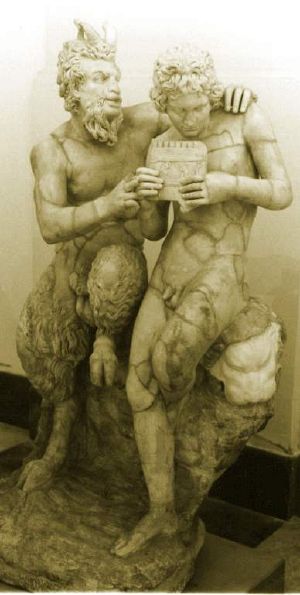
Christian tradition has frequently identified pagan religions and witchcraft with the influence of Satan. In the Middle Ages, the Church accused alleged witches of consorting and conspiring with Satan. Several modern conservative Christian writers, such as Jack Chick and James Dobson, have depicted today's neopagan and witchcraft religions as explicitly Satanic.
Few neopagan traditions recognize Satan or the Devil outright. However, many neopagan groups worship some sort of Horned God, for example, as a consort of the Great Goddess in Wicca. These gods usually reflect mythological figures such as Cernunnos or Pan, and any similarity they may have to the Christian Devil seems to date back only to the nineteenth century, when a Christian reaction to Pan's growing importance in literature and art resulted in his image being translated to that of the Devil.[2]
New Age movement
Participants in the New Age movement have widely varied views about Satan, the Devil, and so forth. In some forms of Esoteric Christianity, Satan remains as a being of evil, or at least a metaphor for sin and materialism, but the most widespread tendency is to deny his existence altogether. Lucifer, on the other hand, in the original Roman sense of "light-bringer," occasionally appears in the literature of certain groups as a metaphorical figure quite distinct from Satan, and without any implications of evil. For example, Theosophy founder Madame Blavatsky named her journal Lucifer, since she intended it to be a "bringer of light."
Many New Age schools of thought follow a nondualistic philosophy that does not recognize a primal force for evil. Even when a dualistic model is followed, this is more often akin to the Chinese system of yin and yang, in which good and evil are explicitly not a complementary duality. Schools of thought that do stress a spiritual war between good and evil or light and darkness include the philosophy of Rudolf Steiner, Agni Yoga, and the Church Universal and Triumphant.
Satanism is a small group within the New Age movement that prefers Satan to God, seeing Satan as a being who promotes freedom and knowledge, while the Christian God is an oppressive tyrant. In effect, the roles of God and the Devil are reversed in this system.
Notes
- â bahai.org, Selections From the Writings of the Báb. Retrieved June 20, 2008.
- â Ronald Hutton, p. 46.
ReferencesISBN links support NWE through referral fees
- Forsyth, Neil. The Old Enemy: Satan & the Combat Myth, Princeton Univ Pr, 1987. ISBN 978-0691014746
- Hutton, Ronald. Triumph of the Moon, a History of Modern Pagan Witchcraft. Oxford: Oxford University Press, 1999. ISBN 978-0192854490
- Pagels, Elaine. The Origin of Satan: How Christians Demonized Jews, Pagans, and Heretics. Vintage, 1996. ISBN 0679731180
- Rudwin, Maximilian Josef. The Devil in Legend and Literature. Ams Pr Inc, 1980. ISBN 978-0404054519
- Russell, Jeffrey Burton. The Devil: Perceptions of Evil from Antiquity to Primitive Christianity. Cornell University Press, 1987. ISBN 978-0801494093
External links
All links retrieved January 29, 2024.
- Catholic Encyclopedia www.newadvent.org
- Children of the Devil www.topical-bible-studies.org
Credits
New World Encyclopedia writers and editors rewrote and completed the Wikipedia article in accordance with New World Encyclopedia standards. This article abides by terms of the Creative Commons CC-by-sa 3.0 License (CC-by-sa), which may be used and disseminated with proper attribution. Credit is due under the terms of this license that can reference both the New World Encyclopedia contributors and the selfless volunteer contributors of the Wikimedia Foundation. To cite this article click here for a list of acceptable citing formats.The history of earlier contributions by wikipedians is accessible to researchers here:
The history of this article since it was imported to New World Encyclopedia:
Note: Some restrictions may apply to use of individual images which are separately licensed.
